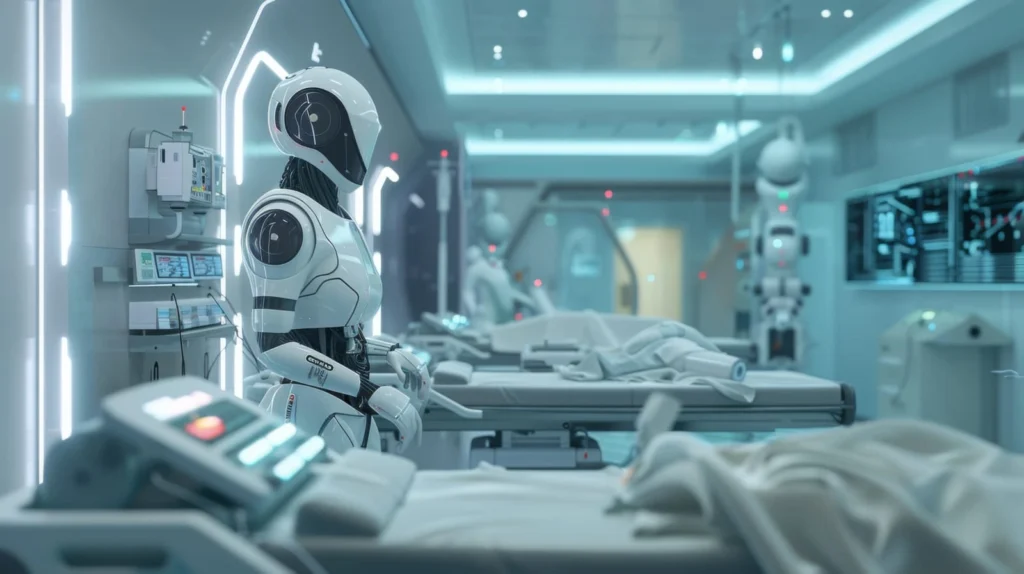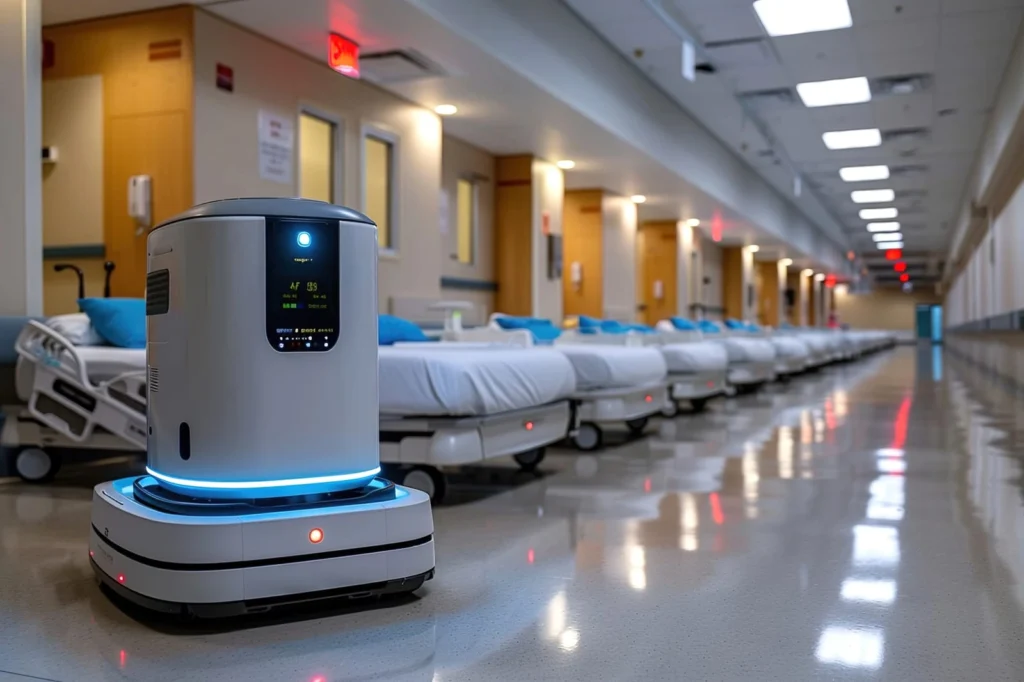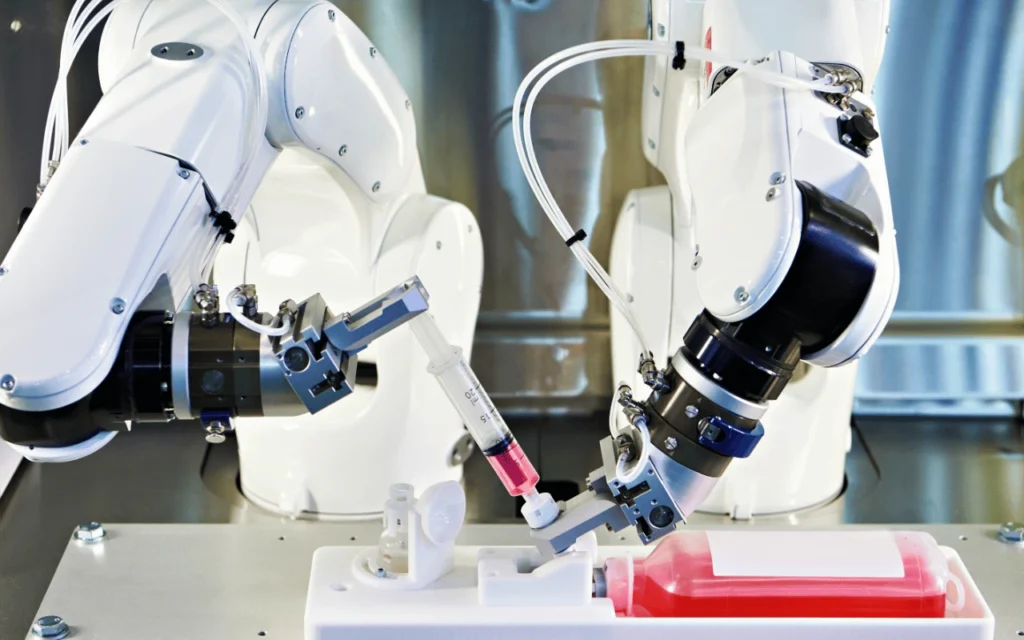China’s rapid demographic shifts, economic growth, and investments in cutting-edge technology have created fertile ground for the future of robotics in healthcare. In 2025, the nation’s population will continue to age rapidly, healthcare labor costs will increase, and the burdens of chronic diseases will rise. Yet China also leads the world in the manufacturing and deployment of industrial robots, and the government has made healthcare robotics a strategic priority.
Hospitals across China are adopting surgical, service, and rehabilitation robots to enhance precision, reduce risks, and extend quality care to remote regions. This article explores how policy, technology, and human expertise are converging to shape the next era of intelligent healthcare in China.
Policy, Market, and Strategic Context

National Policy Frameworks and Government Commitment on The Future of Robotics in Healthcare
China’s leadership sees robotics as a critical pillar for economic resilience and national security. The 14th Five-Year Plan for the Development of the Medical Equipment Industry (2021–2025) aims to achieve breakthroughs in intelligent surgical robots and key technologies, with the goal of domestic production of high-end medical equipment and reducing import cycles.
The Chinese government’s 14th Five-Year Medical Equipment Industry Development Plan, along with the “Robot+ Application Action Plan,” sets targets to build a globally competitive robotics industry and to double the density of robots in manufacturing in 2025.
The value of China’s medical robot market is projected to grow from about 90 billion yuan (US$13 billion) in 2022 to 221 billion yuan (US$32 billion) in 2025, reflecting the government’s emphasis on domestic innovation and adoption.
Local governments, including those in Beijing and Shanghai, have issued policies to create clusters of medical-robot companies and to optimize regulatory approvals and insurance reimbursement, recognizing that pricing and insurance are crucial to the adoption of these technologies.
Market Size and Growth
Industry statistics confirm China’s rapid ascent in robotics. The country became the world’s largest industrial robot market in 2022, with 2.027 million industrial robots operational nationwide by 2024, and Chinese manufacturers captured 57 % of the domestic market share.
While industrial robots dominate the manufacturing sector, the medical robotics segment is experiencing rapid growth. According to the 2023 World Robot Conference report, the Chinese medical robot market was approximately 90 billion yuan ($12.4 billion USD) in 2022 and is projected to reach 221 billion yuan in 2025, representing a compound annual growth rate of over 30%.
China Daily reported that by 2024, the surgical robot market alone had exceeded 10 billion yuan, with domestic devices accounting for 48.9% of installed systems—a 30-percentage-point increase since 2020.
Government support and pandemic‑driven demand for contactless services have accelerated this growth. Hospitals view robots as essential for enhancing efficiency, improving infection control, and expanding access to expertise in underserved regions.
Drivers of Adoption
Several interrelated factors drive the adoption of medical robots in China:
- Demographic pressures – The country’s population aged 65 or above is expected to exceed 300 million in 2025. The ratio of caregivers to elderly residents is low; government sources note that one caregiver often cares for up to ten elderly residents. Robotics is viewed as a means to augment limited human resources and facilitate aging in place.
- Uneven distribution of medical resources – Large urban hospitals attract top surgeons, while remote regions face shortages of skilled personnel. Remote surgery and telemedicine using robots promise to reduce this gap.
- Pandemic safety and infection control – During the COVID-19 pandemic, robots provided contactless delivery, disinfection, and blood-drawing services, thereby reducing the risk to healthcare workers and patients.
- Technological readiness – China’s strengths in 5G connectivity, AI algorithms, and manufacturing enable the development of integrated robotic platforms. Meanwhile, domestic suppliers such as MicroPort, TINAVI, Longwood Valley, Shurei, and Huake are rapidly iterating to compete with international giants.
Innovations in Surgical Robotics

Evolution from Open to Laparoscopic to Robotic Surgery
Surgical robots represent the third revolution in surgery after open and laparoscopic techniques. The standard architecture comprises three core components:
- A video imaging system delivering magnified 3D high‑definition views
- A bedside robotic arm system executing surgical movements with high precision, and
- A surgeon’s control console translates hand movements into micro-motion.
In China, adoption of surgical robots has accelerated due to improvements in 5G networks, imaging technology, and miniaturized robotics.
Domestic Innovation and Competitive Landscape
Historically, foreign systems, such as Intuitive Surgical’s Da Vinci, have dominated the Chinese market, but domestic innovation is changing the landscape. Key players include:
- Shurei (Surrey) – Developed a single‑port laparoscopic robot capable of operating through a 2.5 cm incision with a precision of 0.07–0.1 mm, breaking foreign monopolies. Shurei’s robot minimizes trauma by making a single small incision, broadening indications for minimally invasive surgery.
- Huake Precision – Introduced the SR series neurosurgical robot using 3D structured‑light scanning to reconstruct cranial models in seconds, enabling accurate trajectory planning for stereotactic procedures.
- Longwood Valley MedTech (Romaxs) – Developed the ROPA (Robotic Orthopedic Precision Assistant). This AI-driven orthopedic robot builds personalized 3D models from patient CT data and plans bone-cutting or implant placement. The ROPA system reduces manual preoperative modeling time from a day to 1–3 minutes, provides sub-millimeter optical positioning, and is deployed in more than 1,000 tertiary hospitals across 30 regions, treating over 100,000 patients.
- MicroPort MedBot – A subsidiary of MicroPort Scientific, MedBot covers multiple segments, including endoscopy, orthopedics, vascular intervention, natural‑orifice, and percutaneous puncture systems. Its Toumai surgical robot has been used in complex gastrointestinal, hepatobiliary, urological, and thoracic surgeries.
- TINAVI (Beijing TINAVI Medical) – Producers of the TiRobot for orthopedic procedures. Studies show that 5G-enabled remote TiRobot surgeries result in smaller incisions, reduced blood loss, and fewer complications than local robot‑assisted surgery.
These companies benefit from supportive procurement policies, strong engineering talent, and increasing investor interest. Domestic innovation is closing the gap with foreign competitors, and hospitals are eager to adopt homegrown systems to reduce costs and dependence on imported devices.
Case Studies of Robotic Surgery in China
Single‑Port Robotic Lobectomy
In early 2024, Peking University Third Hospital performed China’s first pure single‑port robotic lobectomy on a 60‑year‑old woman. Surgeons removed an entire lung lobe through a single 2.5 cm incision using a single‑port surgical robot, demonstrating minimal trauma and faster recovery.
The robot’s flexibility and stability allowed the surgeon to operate while seated, reducing fatigue and improving ergonomics. This case highlights how advanced robotics enables procedures previously considered too complex for minimally invasive techniques.
Remote Hepatic Surgery Across Continents
In January 2025, a headline‑making operation saw a Chinese surgeon based in Strasbourg, France, perform a remote liver tumor resection on a patient at a hospital in Hangzhou. The operation lasted 50 minutes and was completed successfully with minimal bleeding, using a domestically produced surgical robot and a 5G network connection.
The remote surgeon manipulated the robot from 10,000 km away using a console with high‑definition imaging and haptic feedback. At the same time, an on‑site team assisted with instrument swaps and patient monitoring.
This demonstration proved that high-quality surgical care can transcend geographical boundaries and that China’s infrastructure and robotics are mature enough to support cross-continental tele-surgery.
Multi-Center Simultaneous Telesurgery
On 22 April 2025, MicroPort MedBot’s Toumai surgical robot enabled five simultaneous telesurgeries across China. Surgeons at Ruijin Hospital in Shanghai’s Remote Surgery Intelligence Center remotely performed pancreatic, hepatic, urological, gastrointestinal, and biliary procedures at hospitals in Fujian, Yunnan, Jiangxi, Hainan, and another district in Shanghai.
For example, a patient in Diqing Prefecture—about 3,000 km away—had a rectal tumor removed. Another patient in Ganzhou, Jiangxi, underwent liver surgery, while others had kidney tumors excised and gallbladders removed. Ultra-high-definition imaging and near-zero-latency 5G connections ensured synchronous control, allowing surgeons to feel tactile feedback and monitor vital signs in real-time.
Hospital administrators hailed this event as a milestone demonstrating that surgeons are no longer bound by physical distance. MedBot emphasized that this cross-regional platform would shape the era of intelligent surgery, making advanced procedures accessible to patients in resource-poor areas.
Outcomes Research: Evaluating Remote Surgery
Academic research supports the efficacy of remote robotic surgery. A retrospective cohort study published in 2024 compared 160 patients with pelvic fractures treated by TiRobot‑assisted surgery. Eighty patients received 5G remote robot surgery, while the other half underwent local robot‑assisted surgery.
The remote group had shorter incision lengths, less intra‑operative blood loss, and fewer complications, with comparable functional outcomes. The authors concluded that 5G remote surgery is precise, minimally invasive, and reliable, and solves the problem of unequal distribution of medical resources.
These findings not only validate the safety of remote surgery but also highlight the potential to expand the reach of specialist care without requiring patient travel.
Hospital Adoption and Surgical Volumes
The adoption of surgical robots in Chinese hospitals has grown dramatically. Zhejiang University Children’s Hospital has performed over 2,300 robot‑assisted surgeries, while Zhengzhou University First Affiliated Hospital has exceeded 13,000.
Institutions such as Harbin Medical University, Beijing Friendship Hospital, and Fudan University are performing complex multi‑organ surgeries using robots. This widespread adoption underscores how robots have evolved beyond experimental novelty to become a routine piece of equipment.
Significantly, each procedure still relies on surgeons; robots remain tools that augment human skill rather than replace it. Surgeons emphasize that robotic systems filter hand tremors, provide 3D high-definition vision, and allow for greater articulation, but clinical judgment and training remain paramount.
Service Robots: Delivery, Disinfection, and Blood‑Drawing
Contactless Delivery and Logistics Robots
During the COVID‑19 pandemic, hospitals faced challenges delivering medications and specimens while minimizing human contact. Chinese firms, such as Keenon Robotics, responded with autonomous delivery robots.
The Keenon M1 robot can carry large infusion containers and deliver items across multiple hospital wards, navigate elevators and obstacles, operate 24/7, and handle deliveries for three to four wards in a single 15-minute run.
Robots utilize lidar and obstacle avoidance algorithms to ensure safe movement, and closed-loop tracking systems log specimen deliveries, thereby improving accountability. Staff reported that these robots reduce labor, decrease the risk of cross-infection, and allow nurses to focus on direct patient care.
Disinfection Robots
Infection prevention is critical in hospitals and nursing homes. Disinfection robots utilize ultraviolet (UV) light or chemical sprays to automatically clean rooms and surfaces. A research note noted robots with fogging rates of up to 1.5 liters per hour that roam wards and record disinfection logs, providing documentation for infection-control audits. Such robots free environmental services staff from hazardous tasks and ensure thorough coverage of the area.
Smart Venipuncture and Self‑Service Blood Draw Centers
One of the most innovative service robots in Chinese hospitals is the smart venous blood‑sampling robot developed by Beijing Mainas Surgical Robot Technology Co. The robot utilizes image recognition to accurately locate veins, improving success rates by 10% and enabling blood draws through thick protective clothing during pandemics.
Patients place their arm in the machine, where the robot aligns the needle, collects blood, and automatically seals the tubes, all within approximately 1 minute. Several hospitals have established AI-powered self-service blood-draw centers where robots guide patients, reducing wait times and freeing phlebotomists for more complex cases.
This technology demonstrates how robots can handle routine procedures, thereby improving efficiency and enhancing the patient experience.
Robots in Rehabilitation and Elder Care

Future of Robotics in Healthcare: Exoskeletons and Assistive Devices
As China’s population ages and stroke incidence rises, rehabilitation robots are gaining prominence. Exoskeleton robots provide power-assisted mobility to individuals with mobility impairments by detecting movement intent using sensors and AI algorithms.
A 70‑year‑old stroke survivor who regained the ability to stand and walk at home by wearing an exoskeleton with hip and knee actuators and multisensory detectors, which predict his intent and deliver propulsion.
This device enables patients to practice gait training independently, eliminating the need for continuous therapist supervision. It underscores how robots can supplement therapy, enabling continuous rehabilitation outside hospital settings and reducing costs.
China has played a role in developing international standards for assistive robots. The International Electrotechnical Commission (IEC) released standards, led by Chinese experts, covering health monitoring, emergency response, and assistance with daily tasks. These standards help to ensure safety and interoperability across devices, paving the way for global acceptance of Chinese‑designed assistive robots.
Human‑Environment Service Robots
Robots for elder care must operate safely among humans, interact naturally, and perform tasks like lifting, carrying, and reminding. In 2025, Tencent’s Robotics X Lab unveiled “The Five,” a human-environment service robot designed for elderly care scenarios. It combines wheeled and quadruped locomotion, tactile skin, dexterous manipulators, and a safety interaction system.
The robot can transfer an elderly person from a bed to a wheelchair, walk with them through corridors, and utilize tactile and visual sensors to prevent falls. It plans paths and interacts with humans through voice instructions, though its emotion recognition and dialect comprehension still need improvement. Such robots highlight the goal of reducing caregiver burden while promoting safe, autonomous living for seniors.
Integration of AI and Home Health Management
AI is central to next‑generation elder‑care robots. The Chinese government recognizes the need to develop embodied AI, where AI models are integrated with robotics, to deliver personalized services to seniors. The 2025 Government Work Report promises to enhance mechanisms for elderly care and promote industries such as embodied AI.
Local governments, including Chongqing and Shenzhen, offer funding for embodied AI to transform digital brains into physical caregivers. Public data show the shortage of caregivers, inspiring robotics to fill the gap.
Assistive robots are not limited to physical tasks; they also provide cognitive stimulation and healthcare monitoring. For example, AI models can remind seniors to take medications, record vital signs, and communicate with family or healthcare providers.
International standards emphasize health monitoring, emergency response, and daily task assistance, reflecting a comprehensive approach to robotic elder care. However, researchers caution that technology alone cannot solve care challenges; humanistic values, ethical considerations, and multi-stakeholder collaboration are also necessary.
Emergence of Humanoid Robots in Healthcare
Beyond assistive devices, Chinese researchers and tech companies are advancing humanoid robots for healthcare environments. Projects supported by institutions such as Tsinghua University and the Harbin Institute of Technology, as well as firms like Fourier Intelligence, focus on developing robots that can assist in nursing, rehabilitation, and patient interaction.
These humanoids are designed to perform complex, human-like tasks—such as turning patients in bed, delivering medication, or guiding physical therapy sessions—using multi-joint actuators, vision sensors, and emotion-recognition AI.
Recent prototypes showcased by Chinese developers demonstrate improved tactile perception and balance control, enabling robots to navigate hospital corridors and operate medical equipment safely.
This push toward human-shaped, embodied caregivers reflects China’s ambition to merge robotics and healthcare AI, addressing its growing shortage of medical and elderly-care workers while strengthening its leadership in service robot innovation.
Artificial Intelligence in Diagnostics and Decision Support
AI‑powered Surgical Planning and Modeling
One of the most significant advances is the integration of AI into robotic systems. Longwood Valley’s ROPA robot utilizes AI deep learning to create personalized 3D models from CT scans in just 1–3 minutes, thereby reducing preoperative planning time and enabling surgeons to simulate operations more effectively.
AI algorithms compute optimal cutting angles and implant positions, and the optical positioning ensures sub‑millimeter accuracy. Clinicians note that AI-driven planning reduces surgery times by approximately 30%, lowering anesthesia exposure and the risk of complications.
AI Pediatricians and Digital Consultation
Chinese hospitals are experimenting with AI systems to enhance clinical decision-making. At Beijing Children’s Hospital, an AI pediatrician has been developed that provides diagnosis and treatment recommendations based on large language models.
In tests, its recommendations align with the conclusions of human expert panels. The AI tool is being integrated into grassroots hospitals and even households via telemedicine platforms. Handling routine cases it can relieve pediatricians’ workload and allow specialists to focus on complex patients.
Medical Large Language Models and Imaging Analysis
Investment in AI has accelerated the development of domain‑specific large models. CITIC Securities reports that by late 2024, more than 50 large vertical AI models had been developed in the Chinese healthcare sector. These models support triage, medical image interpretation, pathology diagnosis, and cognitive function screening. For example:
- Early cognitive impairment screening – Peking Union Medical College Hospital’s AI system uses voice and behavioral data to identify early signs of cognitive decline.
- Pathology diagnosis – Shanghai’s Ruijin Hospital, in collaboration with Huawei, uses the RuiPath model to analyze pathology slides, reducing analysis time from several minutes to seconds.
- Medical image interpretation and triage – AI systems can interpret radiological scans, flag anomalies, and triage patients, streamlining workflow and reducing waiting times.
The emergence of these models signals China’s ambition to become a global leader in AI healthcare innovation. Experts emphasize that AI should be used to relieve doctors’ repetitive tasks rather than replace them, allowing more time for patient interaction and humanistic care. Developing transparent, safe, and ethically compliant AI is essential for building trust and fostering adoption.
Future of Robotics in Healthcare: Ethical, Social, and Regulatory Considerations

Surgeon Training and Workforce Implications
One concern is how robots will impact employment for surgeons and healthcare workers. In reality, robots serve as tools that augment rather than replace clinicians. Surgeons still control the robotic arms and make decisions; robotics reduces physical strain and filters tremors, but expertise remains essential.
However, adoption requires extensive training; operating a robot demands proficiency in both surgical techniques and system interfaces. Hospitals must invest in training programs and simulation labs to ensure the safe use of these devices. Younger surgeons may adapt quickly, while older practitioners may need additional support.
Data Privacy and Cybersecurity
Remote surgery, AI diagnostics, and robot-assisted care rely on high-definition imaging, personal health data, and robust network connectivity. Safeguarding patient data and preventing cyber‑attacks are critical. China’s Data Security Law and Personal Information Protection Law impose strict requirements on data collection, cross-border data transfers, and device security.
Manufacturers and hospitals must implement encryption, regular security audits, and contingency plans. Potential vulnerabilities include unauthorized access to surgical robots during remote procedures, hacking of home‑care robots to invade privacy or sabotage, and misuse of patient data. Trust in robots will depend on robust cybersecurity and regulatory oversight.
Equity and Access
While robots promise to democratize access to healthcare, there is a risk that only affluent hospitals and urban centers will reap the benefits. Government policies aim to prevent widening disparities by subsidizing robotics and promoting their adoption in county hospitals.
Tele‑surgery and AI diagnostic platforms help to bridge geographical gaps, but robust network infrastructure and training are prerequisites. Future initiatives should include reimbursement schemes to ensure rural patients can access robot‑assisted care.
Ethical Interactions and Humanistic Care
As robots become more integrated in patient care, maintaining humanistic values is vital. AI systems that triage patients or deliver elder care must be designed with empathy and respect. Researchers caution that robots should support, rather than supplant, human caregivers, and that human warmth remains crucial for mental and emotional well-being.
For elderly users, natural language interaction, emotion recognition, and cultural sensitivity are necessary for acceptance. Developers should collaborate with psychologists, gerontologists, and ethicists to incorporate humanistic principles into their design.
Regulatory Approval and Reimbursement
China’s National Medical Products Administration (NMPA) and National Health Commission regulate medical devices and procedures. Robotic systems must undergo rigorous clinical trials and pass product registration—the approval of domestic robots such as the TiRobot, Toumai, and ROPA signals regulatory support and trust.
However, for robots to scale in hospitals, insurance reimbursement for robot‑assisted procedures must be addressed. The Chinese Medical Equipment Association emphasizes the importance of policies that include robotic surgery in insurance coverage and establish guidelines for pricing and reimbursement. Without such policies, patients may face higher out-of-pocket costs, which can limit uptake.
Future Outlook and Strategic Implications on Future of Robotics in Healthcare

Convergence of Technologies
The future of medical robotics in China lies at the intersection of multiple technologies: 5G/6G networks, AI, machine vision, haptics, wearables, and cloud computing. Real-time remote control requires ultra-low latency. In 2025, pilot programs utilizing 5G+ networks are expected to expand to rural hospitals, and early tests of 6G are anticipated to commence.
AI algorithms will continuously learn from surgical data, improving precision and predicting complications. Augmented reality (AR) and virtual reality (VR) will provide surgeons with immersive views and training experiences.
Cloud platforms will host digital twins of patients, enabling personalized planning and simulation. Chinese companies are investing heavily in this convergence, and the state encourages cross‑industry collaboration.
Integration Across the Care Continuum
Robots will not remain isolated devices but will become part of holistic care pathways. For example, a cancer patient might first engage with an AI system for triage, then undergo robot‑assisted imaging and biopsy, followed by remote surgery using a surgical robot and remote monitoring with wearable sensors and home‑care robots.
Data collected across these stages will feed back into AI models, creating a learning healthcare system. This integration requires interoperability standards, unified data platforms, and collaboration between device makers, software developers, and healthcare providers.
China’s leadership in establishing international standards for assistive robots hints at its ambitions to shape global norms.
Global Collaboration and Competition
China aims to become a global hub for medical‑robot innovation. Domestic companies are expanding abroad, and foreign firms are entering joint ventures or establishing research and development centers in China. The cross‑continental remote surgery between France and China demonstrates international collaboration.
Competition is likely to intensify as Chinese systems challenge established Western products in terms of price and performance. Intellectual property disputes, export controls, and geopolitical tensions could impact supply chains.
Nevertheless, global health challenges—such as aging populations and pandemic preparedness—require cooperation, and Chinese robots may play a crucial role in enhancing global healthcare resilience.
Societal Acceptance and Workforce Transformation
Public perception will shape the trajectory of robotics in healthcare. Surveys indicate that Chinese citizens are optimistic about AI and robotics, particularly among younger generations. Senior citizens may be wary of robots; however, case studies show strong acceptance when devices demonstrably improve autonomy, as with the stroke survivor using an exoskeleton.
Education and outreach programs can demystify the technology, and demonstration projects, such as self-service blood draw centers, help build familiarity with it.
Robotics will also reshape the healthcare workforce. Surgeons will require training in robotics, teleoperation, and AI-driven decision-making. Nurses and allied health professionals may transition into roles operating or monitoring robots, analyzing data, and providing remote patient support.
New professions—such as robotic maintenance specialists, AI ethicists, and cybersecurity experts—will emerge. Universities and medical schools must update curricula to prepare graduates for this hybrid environment.
Long‑Term Vision
Looking beyond 2025, China envisions an integrated network where robots, AI, and human caregivers work in seamless collaboration. Hospitals will evolve into “smart hospitals” with automated logistics, robotic pharmacies, and AI triage.
Community clinics will connect to tertiary centers through tele-surgery and tele-diagnosis. Home‑care robots will monitor health, provide companionship, and reduce hospital admissions. Rehabilitation and assistive robots will enable aging in place, supporting China’s policy goal of shifting care from institutions to communities.
Achieving this vision requires continued investment in research, standards, infrastructure, and inclusive policy. It also demands adherence to ethical principles, patient privacy, and equity, ensuring that technology serves all citizens.
Learn How China’s Tech Future Shapes Global Healthcare — With Ashley Dudarenok
China’s medical robotics boom reflects a wider transformation led by AI, digital ecosystems, and innovation-driven policy. To truly understand what’s next, you need insights from those who’ve spent years decoding China’s fast-evolving digital industries.
Ashley Dudarenok — serial entrepreneur, China digital expert, and global keynote speaker — helps executives and healthcare innovators translate China’s breakthroughs into actionable global strategies. Through keynotes, consulting, and executive learning sessions, she unpacks how Chinese innovation in AI, robotics, and customer-centric systems is redefining global healthcare and business models.
Gain clarity on:
- How China’s policies and private tech giants drive real-world robotics adoption
- What global organizations can learn from China’s speed of digital transformation
- How to position your business for the next wave of AI-driven healthcare
Book a strategy session or keynote with Ashley Dudarenok to explore how your organization can adapt, compete, and lead in the era of intelligent healthcare.
FAQs: Future of Robotics in Healthcare
How do medical robots influence rural and under-resourced regions in China?
Robots in China’s less-developed counties help offset doctor shortages by enabling remote diagnosis, telesurgery, and automated nursing support. For example, a robot-assisted diagnosis center in Yunnan connects patients with specialists in Beijing, reducing travel burden and improving diagnostic speed. These systems allow standard-of-care delivery even in remote towns, narrowing regional health disparities.
What training models are used to upskill medical staff to work with robots?
Hospitals partner with universities and robotics firms to run immersive boot camps, virtual-reality surgical simulators, and apprenticeship rotations. For instance, a Shanghai hospital uses VR simulation modules before surgeons operate via robots. This blend of hands-on practice and supervised deployment builds confidence, ensuring clinicians don’t “fear the machine”—they collaborate with it.
How do Chinese hospitals measure ROI (return on investment) for medical robotics?
Hospital administrators typically track metrics like procedural volume increase, reduced length of stay, fewer complications, higher surgical throughput, and lower readmission rates. They map capital and maintenance costs against revenue gains and savings. Some hospitals report a payback period of 5–8 years for robot systems after scaling their usage across multiple departments.
What data security frameworks protect patient privacy when robots are networked?
Chinese hospitals are adopting localized data isolation, encrypted tunnels, and redundant backups to safeguard imaging and patient records that flow through robotic systems. Access is restricted via role-based permissions and multi-factor authentication. Some institutions mirror their approach from finance: sensitive algorithms and images remain on-premises, while only metadata is sent to cloud nodes.
How do robots assist in emergency and critical care settings?
In ICUs and emergency wards, robots can carry equipment, deliver medications, monitor vital signs, and assist with patient transport within the hospital. For example, after a critical surgery, a robot may shuttle lab samples to the central lab or replenish supplies in sterile zones. This reduces the burden on non-clinical staff, freeing clinicians to focus on acute decision-making.
How are robotic “companions” used in mental health and elderly care?
Beyond their mechanical function, companion robots help elderly patients stay socially engaged by offering reminders, conversation prompts, mood detection, and simple games. Some pilot studies in Guangdong show that these robots reduce loneliness scores and encourage medication adherence. Because they’re integrated with hospital systems, clinicians can remotely monitor behavioral trends.
What interoperability standards (between robots, hospital systems, and medical devices) are emerging in China?
China is pushing standards like HL7 FHIR and the China National Health Standard to ensure robots can speak the same “language” as HIS, PACS, EMR, and IoT devices. This lets robots take orders (e.g. “deliver this drug to ward 3”) directly from existing hospital systems. Some leading projects utilize standard APIs, enabling robots to scale seamlessly across hospitals.
How are maintenance and service models structured for deployed medical robots?
Robotics firms often supply “robot-as-a-service” contracts: hospitals pay for uptime rather than full ownership. The vendor handles firmware updates, preventive maintenance, part replacements, and remote monitoring. For high-end surgical units, some firms station service engineers on-site in large hospitals for rapid response.
What is the role of local Chinese component supply chains in robot manufacture?
To reduce reliance on foreign parts and avoid export restrictions, many Chinese medical-robot companies now source motors, sensors, and control chips from domestic suppliers in Shenzhen, Suzhou, or Chengdu. This vertical integration helps control cost, shorten lead times, and stabilize supply even under global trade tension.
How does patient acceptance of robots differ by demographic (age, region, education)?
Surveys show that younger and more urban patients are more receptive to robot-assisted diagnosis or surgery. Older patients or those in rural areas often express concern about “machines making decisions.” Hospitals address this issue through orientation sessions, testimonials, and allowing patients to “meet” the robot ahead of procedures, which boosts trust.
Can robots assist in preventative and home-based care in China?
Yes. Some robots are deployed in homes to monitor chronic conditions (e.g., hypertension or diabetes), take vitals daily, detect anomalies, and alert hospitals. In pilot zones in Zhejiang, patients use robots that transmit daily readings to local clinics; clinic staff intervene when alerts trigger. This reduces outpatient pressure and enables early disease control.
How do robotics firms in China collaborate with medical schools and research hospitals?
Joint labs are common: robotics firms embed engineers in teaching hospitals; in turn, surgeons act as “product co-designers.” The hospital may provide patient data, procedure feedback, and clinical testing. This co-development accelerates adaptation to real workflows. For example, the robotics arm at Peking Union Medical College collaborates directly with startups to refine ergonomics and AI modules.
What regional clustering of medical robotics development can we observe?
Cities like Shenzhen, Shanghai, Suzhou, and Chengdu host dense clusters of robotics startups, manufacturing hubs, and hospital testbeds. These geographies offer access to supply chains, venture capital, and pilot hospitals. For instance, a robot firm in Suzhou may prototype with a local Grade-3 hospital before scaling nationally.
How do funding models (venture, government grants, PPPs) support robotic adoption in hospitals?
Early-stage robotics firms often secure seed funding from local governments in industrial parks, while mature projects leverage public–private partnerships (PPPs) with municipal health bureaus. Some provincial health departments offer matching grants or subsidies to hospitals that adopt robotics, thereby reducing the initial investment burden.
What are the contingency strategies when a robot fails mid-procedure or loses connectivity?
Hospitals build fallback paths: the human surgeon must be ready to convert to manual mode instantly. Robotics systems include “safe mode” protocols (e.g., freezing motion, retracting to a safe position). Network redundancies (multiple links, local caches) ensure key commands don’t depend on a single network path. These strategies ensure patient safety in the event of technology hiccups.

